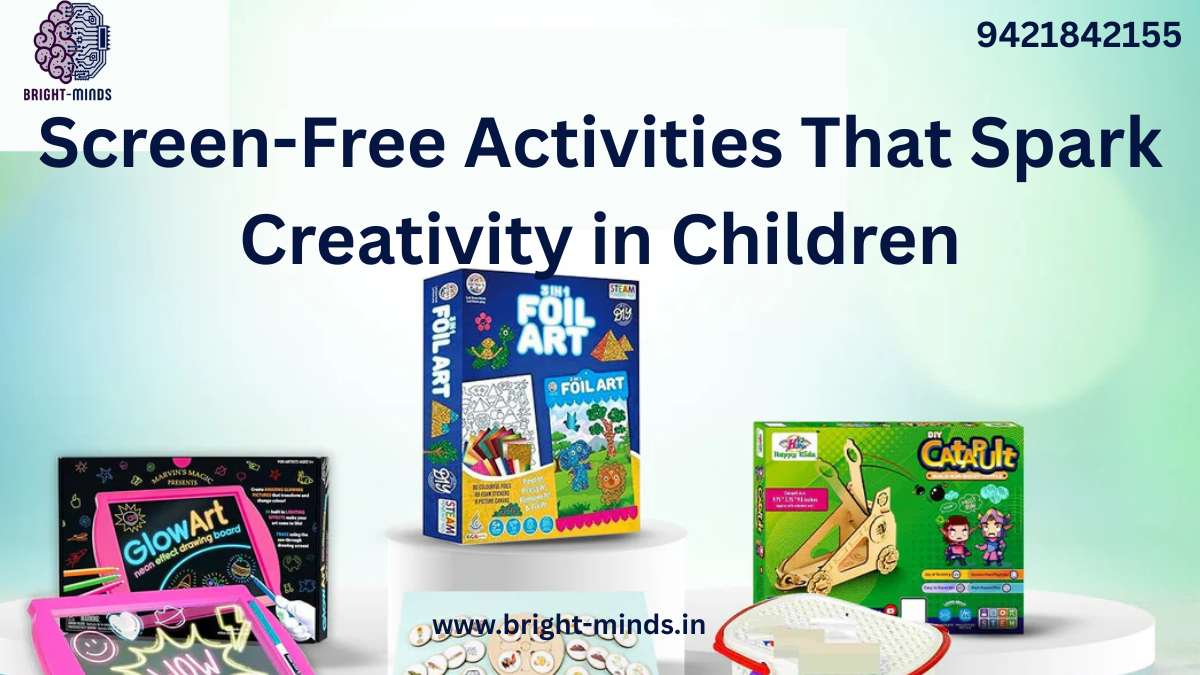In today’s digital world, screens are everywhere. From tablets and smartphones to educational videos and online games, children are exposed to technology more than ever before. While tech has its place, the growing concern among parents and educators is that too much screen time may stifle a child’s creativity, social skills, and even their mental well-being.
So, how can we encourage creativity in children without screens?
Let’s dive into some powerful screen-free activities that not only spark creativity but also support healthy development—for home and even workplace environments like family day programs.
🎨 Why Screen-Free Activities Matter
According to the American Academy of Pediatrics, children aged 2 to 5 should have no more than one hour of screen time per day. However, studies show many children exceed this by hours. Excessive screen time has been linked to:
- Reduced attention spans
- Delayed language development
- Limited imaginative play
- Fewer face-to-face social interactions
In contrast, screen-free creative activities help develop:
- Problem-solving skills
- Imagination and storytelling
- Fine motor skills
- Emotional expression
- Teamwork and social interaction
For companies that offer childcare programs or parent-focused initiatives, promoting screen-free creativity isn’t just good for kids—it’s a positive reflection on your brand’s commitment to work-life balance.
🧠 Creativity Begins with Curiosity
Creativity isn’t about being artistic; it’s about thinking outside the box. And children are naturally curious—we just need to give them the right tools and opportunities.
🧺 10 Engaging Screen-Free Activities That Boost Creativity
Here are practical and fun ideas that can be implemented at home, in classrooms, or during corporate family events:
1. DIY Craft Stations
Set up a table with recyclable materials—bottle caps, cardboard, fabric scraps, buttons. Let children build their own inventions, robots, or creatures.
🧠 Creativity boost: Encourages design thinking and problem-solving.
2. Story Cubes
Use dice with pictures or words on each side. Kids roll and build a story based on the results.
🧠 Creativity boost: Sparks imagination and storytelling.
3. Outdoor Nature Scavenger Hunts
Create a checklist of natural items like pinecones, feathers, or oddly shaped rocks. Kids explore and collect.
🧠 Creativity boost: Encourages observation, exploration, and natural science learning.
4. Puppet Theater
Use socks or paper bags to make puppets. Let children create their own plays and act them out.
🧠 Creativity boost: Builds narrative skills and confidence.
5. Sensory Play Bins
Fill tubs with materials like rice, beans, or kinetic sand. Add scoops, funnels, and small toys.
🧠 Creativity boost: Enhances tactile learning and imagination.
6. Cardboard Architecture
Hand kids a stack of old cardboard boxes and some masking tape. Watch as they build castles, rockets, or even entire cities.
🧠 Creativity boost: Teaches spatial awareness and engineering basics.
7. Music Jam Sessions
Bring out pots, pans, spoons, or actual instruments. Encourage kids to create a song or rhythm pattern.
🧠 Creativity boost: Develops auditory skills and emotional expression.
8. Drawing Prompts
Give kids open-ended prompts like “draw your dream island” or “invent a new animal.”
🧠 Creativity boost: Strengthens visualization and fine motor skills.
9. Cooking or Baking Together
Let kids decorate cupcakes, mix their own smoothies, or help prepare simple meals.
🧠 Creativity boost: Teaches sequencing, measurement, and experimentation.
10. Mindful Movement or Yoga
Simple poses and breathing exercises not only improve focus but also unlock imaginative thinking through body awareness.
🧠 Creativity boost: Supports mental clarity and emotional regulation.
📈 Industry Insights: The Market for Creative Learning is Growing
According to a report by Research and Markets, the global market for creative educational toys and screen-free learning is expected to grow significantly by 2030, driven by:
- Increasing screen time concerns
- Rise in homeschooling and hybrid learning
- Corporate wellness programs for families
- Government awareness initiatives around early childhood development
Companies that invest in family-friendly environments and child-focused programs can attract top talent and foster employee satisfaction. Offering creativity-based kits or weekend workshops can be a great CSR or HR initiative.
💡 Real-World Application: Home & Workplace
For parents: Set screen-free hours in your home where creative play is encouraged. You’ll likely notice better moods, more engagement, and less reliance on devices for entertainment.
For companies: Consider hosting “Family Creativity Days” where kids and parents engage in hands-on learning together. These events can double as team-building and stress relief for your staff.
✅ Practical Tips for Getting Started
- Create a “creativity corner” at home or in your office daycare.
- Rotate materials weekly to keep things fresh.
- Encourage open-ended play—no right or wrong answers.
- Join in! Kids love it when adults participate too.
- Celebrate the process, not just the outcome.
🚀 Ready to Take the Next Step?
Want to go beyond the basics? Explore our expert-led courses on child development, early learning, and creativity coaching—all designed to empower parents, educators, and professionals.
👉 Browse our advanced learning resources
👨👩👧👦 Unlock your child’s potential with the right tools and knowledge!
📌 Conclusion
In a world filled with digital noise, screen-free creativity is a gift you can give your child—one that shapes how they think, express, and solve problems. Whether you’re a parent, teacher, or company leader, encouraging screen-free creative play is a powerful step toward raising curious, confident, and capable young minds.
You might be interested in this:
Top Amusement and Theme Parks Around the World
Exploring General Knowledge: Gk Questions for Class 1 to 8 with Answers

